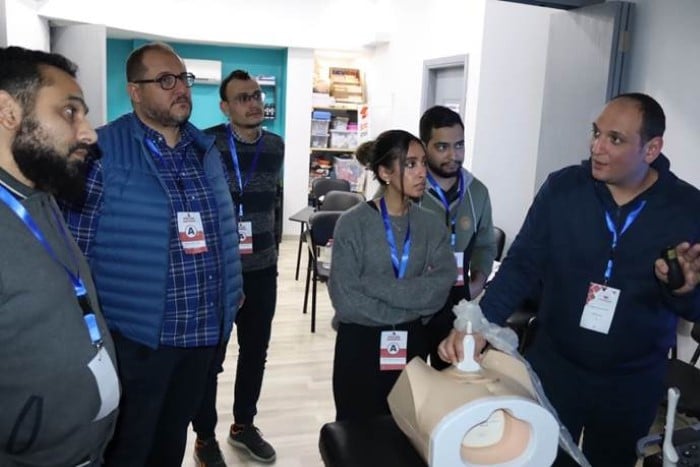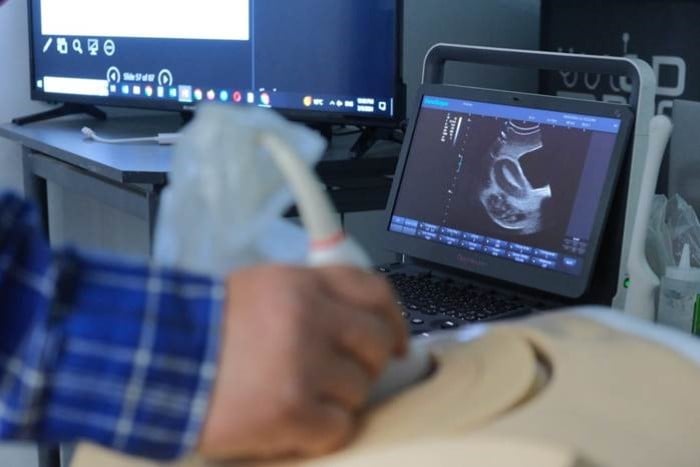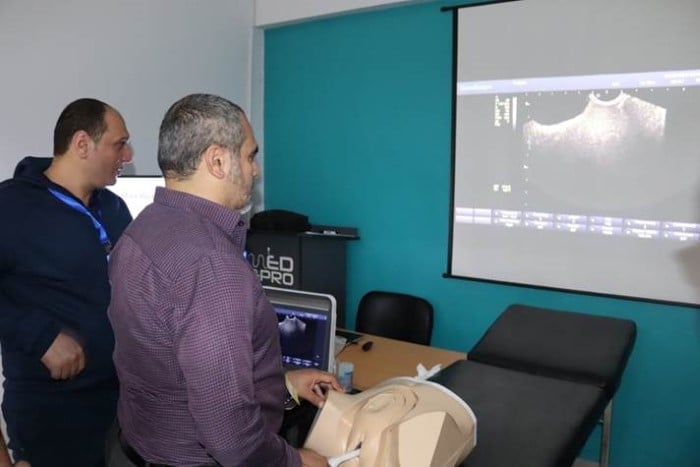
Developing an Obstetric POCUS course for North Africa and the Middle East
Wesam Ibrahim MD, PhD
Department of Surgery, School of Medicine, University of Colorado Denver and Emergency Medicine and Traumatology Department, Tanta University, Egypt
Grace Wanjiku MD, MPH
Assistant Professor of Emergency Medicine, Section of Global Emergency Medicine, The Warren Alpert Medical School of Brown University
It is estimated that emergency medical diseases account for 50% of all global mortality, and that the burden of emergency diseases is 4.4 times higher in Low- and Middle-Income Countries (LMICs) compared to High-Income Countries (HICs).1 Maternal morbidity and mortality is a significant contributor to this high burden of emergency medical diseases. In 2020, it was estimated that 800 women died daily from preventable causes related to pregnancy and childbirth, translating to one death every two minutes.2 Egypt has made significant progress in meeting the SDG 3.1 target of maternal mortality ratio of less than 70 per 100,000 live births. However, recent trends including conflict and mass immigration could reverse this trend in Egypt as well as other countries in North Africa and the Middle East.
The use of point-of care ultrasound (POCUS) in the acute or critical care setting is an important tool in the effort to reduce adverse maternal and neonatal outcomes in LMICs.3 The use of Obstetric POCUS has increased globally, allowing for doctors, nurses and midwives to diagnose emergent obstetric conditions in settings where trained radiologists or sonographers are limited.4 In Egypt as in other LMICs, the emergency department is the key point of entry into the health care system for the majority of patients, including pregnant women.5 The WHO essential package of emergency care recommends the use of POCUS in LMIC emergency departments.6 As ultrasound technology evolves to be more portable and cost effective, the demand for POCUS training and implementation continues to grow globally.7 Thus there is a need for robust and sustainable POCUS training programs to respond to this increasing need.
Sonoschool,8 a POCUS training program was started by Egyptian emergency physicians in 2016. The goal was to provide internationally accredited POCUS training modules in the Middle East and North Africa (MENA) region. However, due to religious and cultural norms, it has been challenging to create an emergency obstetric POCUS course. Pregnant patients who present to the ED are immediately sent to the Obstetrics and Gynecology (OB GYN) department without any assessment of their pregnancy, including emergent indications. This can lead to dangerous delays in care, especially in pregnant women who may have other acute reasons to present e.g. injury or cardiopulmonary emergencies. Thus there is a critical need to equip emergency providers with key skills in emergency obstetric POCUS that can help them in the resuscitation and stabilization of pregnant women in collaboration with OB GYN.
A fortuitous meeting between Dr. Wesam Ibrahim and Dr. Grace Wanjiku helped with the goal of building SonoSchool’s first Obstetric POCUS course. In 2015-2016, Dr. Ibrahim was a visiting fellow in the department of emergency medicine at Yale School of Medicine where Dr. Wanjiku was also pursuing her acute and critical care ultrasound fellowship. In 2016, Dr. Wanjiku taught a POCUS in obstetrics course as part of the pre-conference workshops at the Third African Conference on Emergency Medicine in Cairo Egypt. This was the first time that emergency obstetric POCUS had ever been taught in Egypt. In 2023, Dr. Wanjiku was invited by Dr. Ibrahim to serve as the chair of SonoSchool’s clinical advisory team. In her role, Dr. Wanjiku designed and taught a one-day Obstetric POCUS course in Sheikh Zayed City, Egypt. The course was attended by a group of SonoSchool’s core trainers from Egypt, Libya and Yemen.
The course was overall well received, with specific feedback asking for more hands-on time, more cases and probably a second day to allow for the inclusion of more gynecologic non-obstetric pathology. One of the trainees asked for the inclusion of an ethics module. Indeed, this is an important consideration given cultural and religious norms that impact obstetric POCUS training and performance in the MENA region. For example, it is particularly challenging to recruit pregnant women for hands-on training, which is highly desired by trainees. We used a simulator for first trimester trans-abdominal and transvaginal scanning, and this skill station was highly ranked. We were fortunate to have one woman volunteer for second/third trimester scanning. However, this station had limited hands-on time and accordingly was ranked lower by trainees.
Despite the limitations, this was the first opportunity, especially for emergency medicine practitioners, to perform obstetric POCUS on a live model. The course is a work in progress, and we are using the feedback from the core group that was trained to include more cases, maximize hands-on time within the constraints described and to eventually seek international accreditation. We are seeking to develop a course that is appropriate for its context with the understanding that the teaching approach might look different from other LMIC regions.
SonoSchool Sample Agenda

References
- Razzak J, Usmani MF, Bhutta ZA. Global, regional and national burden of emergency medical diseases using specific emergency disease indicators: analysis of the 2015 Global Burden of Disease Study. BMJ Glob Health. 2019;4(2):e000733.
- Trends in maternal mortality 2000 to 2020: estimates by WHO, UNICEF, UNFPA, World Bank Group and UNDESA/Population Division. Geneva: World Health Organization; 2023. License: CC BY-NC-SA 3.0 IGO.
- WHO Technical Report Series (2018) WHO recommendations on antenatal care for a positive pregnancy experience: summary. WHO, Geneva. License: CC BY-NC-SA 3.0 IGO. WHO/RHR/18.01. [Internet]. Available from: https://apps.who.int/iris/bitstream/handle/10665/259947/WHO-RHR-18.02-eng.pdf?sequence=1&isAllowed=y
- Harris RD, Marks WM. Compact Ultrasound for Improving Maternal and Perinatal Care in Low-Resource Settings. J Ultrasound Med. 2009;28(8):1067-76.
- Ngaruiya C, Kawira A, Mali F, Kambua F, Mwangi B, Wambua M, et al. Systematic review on epidemiology, interventions and management of noncommunicable diseases in acute and emergency care settings in Kenya. African J Emerg Med. 2021;11(2):264-76.
- Reynolds TA, Sawe H, Rubiano AM, et al. Strengthening Health Systems to Provide Emergency Care. In: Jamison DT, Gelband H, Horton S, et al., editors. Disease Control Priorities: Improving Health and Reducing Poverty. 3rd edition. Washington (DC): The International Bank for Reconstruction and Development / The World Bank; 2017 Nov 27. Chapter 13. Available from: https://www.ncbi.nlm.nih.gov/books/NBK525279/ doi: 10.1596/978-1-4648-0527-1_ch13. In.
- Becker DM, Tafoya CA, Becker SL, Kruger GH, Tafoya MJ, Becker TK. The use of portable ultrasound devices in low‐ and middle‐income countries: a systematic review of the literature. Trop Med Int Health. 2016;21(3):294-311.
- SonoSchool Website. https://www.sonoschool.org/
 Dr. Nabil Hussein, emergency physician from Egypt and member of SonoSchool’s board of directors performs transvaginal ultrasound on a simulator under Dr. Wanjiku’s guidance
Dr. Nabil Hussein, emergency physician from Egypt and member of SonoSchool’s board of directors performs transvaginal ultrasound on a simulator under Dr. Wanjiku’s guidance
 Dr. Mohamed Nasreddin, emergency physician from Egypt leading
Dr. Mohamed Nasreddin, emergency physician from Egypt leading
hands-on training on first trimester Obstetrics POCUS
 Sagittal view of the female pelvis on the simulator
Sagittal view of the female pelvis on the simulator
 Dr. Haitham Khalifa, emergency physician from Egypt and member of SonoSchool’s board of directors
Dr. Haitham Khalifa, emergency physician from Egypt and member of SonoSchool’s board of directors
performs transvaginal ultrasound

